The Importance of Emotional Intelligence in Leadership: Assignment
VerifiedAdded on 2023/02/02
|13
|3464
|83
Homework Assignment
AI Summary
This assignment delves into the multifaceted concept of emotional intelligence (EI) within a leadership context. It begins by defining EI and its key attributes, exploring the benefits of emotionally intelligent team members and the positive impact on workplace relationships. The assignment then examines emotional strength and weakness, the purpose and variations of human emotions, and the definition and impact of stress and emotional triggers on individual well-being. Furthermore, it identifies the importance of leaders modeling EI, provides examples of non-verbal emotional expression, and discusses cultural variations in emotional expression. The assignment also addresses the importance of flexibility and adaptability in leadership decision-making, analyzing negative and positive emotional climates and suggesting leadership styles to foster a positive environment. It concludes by outlining techniques to encourage emotional expression, analyze the utilization of emotional strength within teams, and provides a case study (Assessment 3) that applies these concepts to a real-world workplace scenario, considering cultural demographics, emotional needs, and strategies for promoting and improving emotional intelligence within a team.
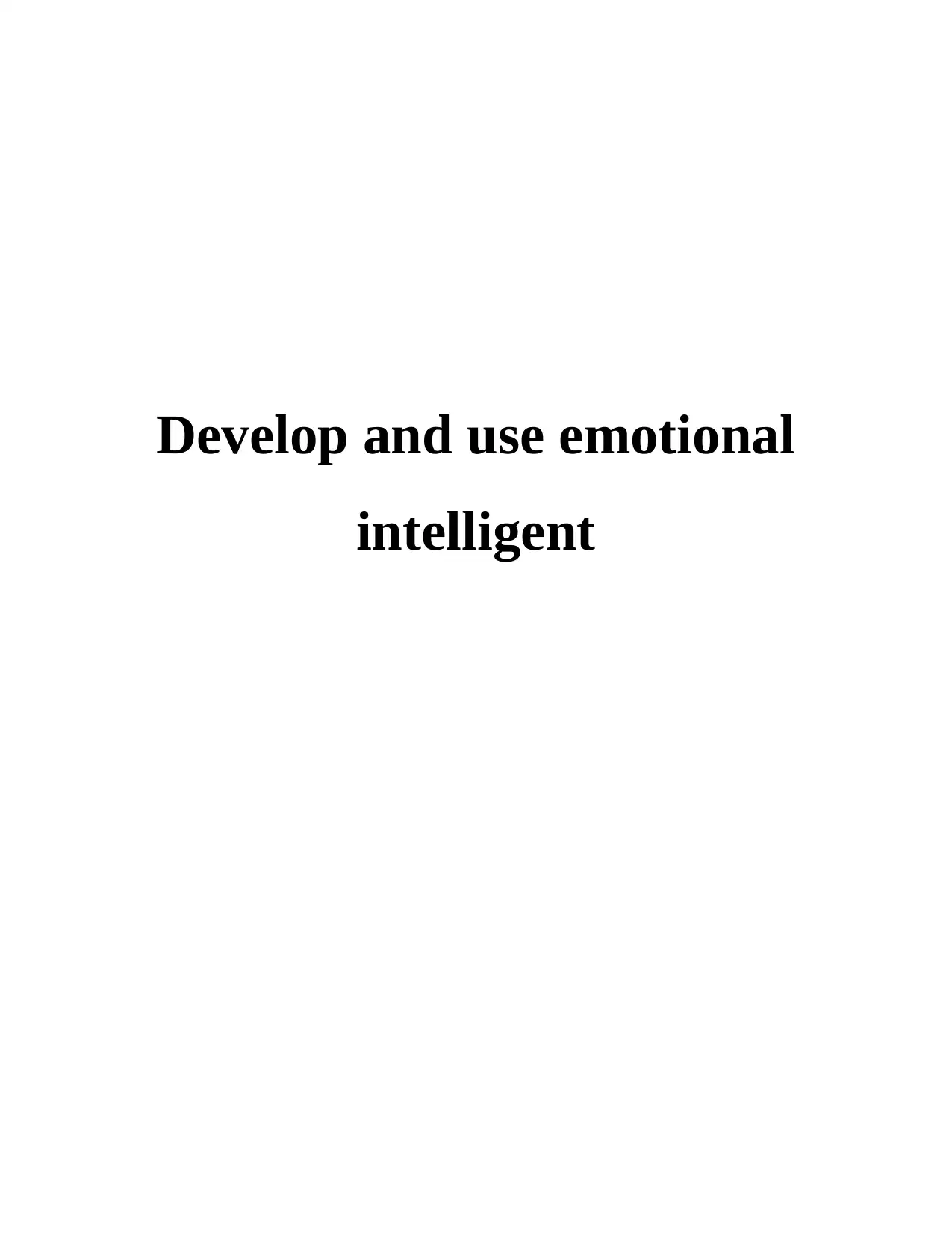
Develop and use emotional
intelligent
intelligent
Paraphrase This Document
Need a fresh take? Get an instant paraphrase of this document with our AI Paraphraser
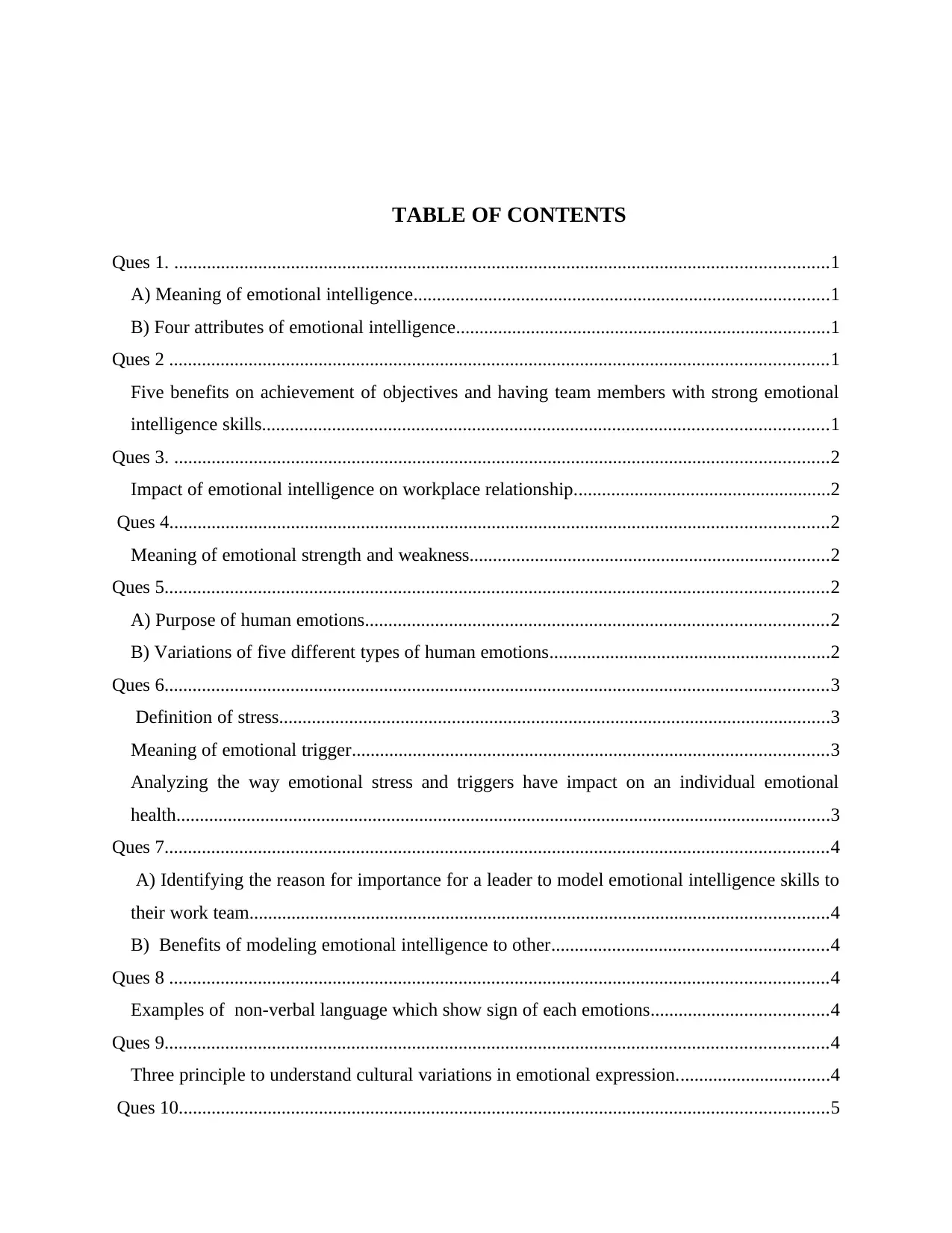
TABLE OF CONTENTS
Ques 1. ............................................................................................................................................1
A) Meaning of emotional intelligence.........................................................................................1
B) Four attributes of emotional intelligence................................................................................1
Ques 2 .............................................................................................................................................1
Five benefits on achievement of objectives and having team members with strong emotional
intelligence skills.........................................................................................................................1
Ques 3. ............................................................................................................................................2
Impact of emotional intelligence on workplace relationship.......................................................2
Ques 4.............................................................................................................................................2
Meaning of emotional strength and weakness.............................................................................2
Ques 5..............................................................................................................................................2
A) Purpose of human emotions...................................................................................................2
B) Variations of five different types of human emotions............................................................2
Ques 6..............................................................................................................................................3
Definition of stress......................................................................................................................3
Meaning of emotional trigger......................................................................................................3
Analyzing the way emotional stress and triggers have impact on an individual emotional
health............................................................................................................................................3
Ques 7..............................................................................................................................................4
A) Identifying the reason for importance for a leader to model emotional intelligence skills to
their work team............................................................................................................................4
B) Benefits of modeling emotional intelligence to other...........................................................4
Ques 8 .............................................................................................................................................4
Examples of non-verbal language which show sign of each emotions......................................4
Ques 9..............................................................................................................................................4
Three principle to understand cultural variations in emotional expression.................................4
Ques 10...........................................................................................................................................5
Ques 1. ............................................................................................................................................1
A) Meaning of emotional intelligence.........................................................................................1
B) Four attributes of emotional intelligence................................................................................1
Ques 2 .............................................................................................................................................1
Five benefits on achievement of objectives and having team members with strong emotional
intelligence skills.........................................................................................................................1
Ques 3. ............................................................................................................................................2
Impact of emotional intelligence on workplace relationship.......................................................2
Ques 4.............................................................................................................................................2
Meaning of emotional strength and weakness.............................................................................2
Ques 5..............................................................................................................................................2
A) Purpose of human emotions...................................................................................................2
B) Variations of five different types of human emotions............................................................2
Ques 6..............................................................................................................................................3
Definition of stress......................................................................................................................3
Meaning of emotional trigger......................................................................................................3
Analyzing the way emotional stress and triggers have impact on an individual emotional
health............................................................................................................................................3
Ques 7..............................................................................................................................................4
A) Identifying the reason for importance for a leader to model emotional intelligence skills to
their work team............................................................................................................................4
B) Benefits of modeling emotional intelligence to other...........................................................4
Ques 8 .............................................................................................................................................4
Examples of non-verbal language which show sign of each emotions......................................4
Ques 9..............................................................................................................................................4
Three principle to understand cultural variations in emotional expression.................................4
Ques 10...........................................................................................................................................5
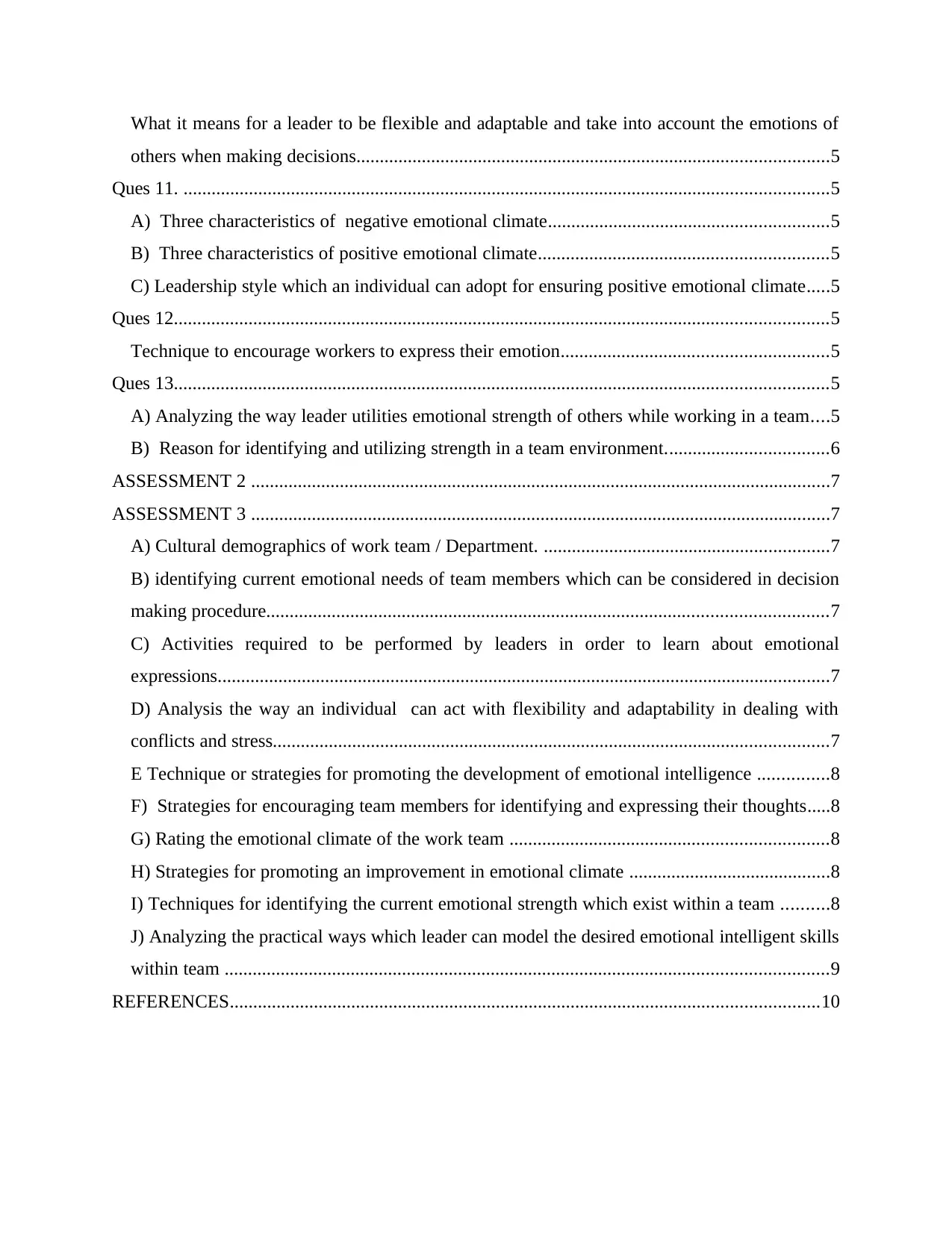
What it means for a leader to be flexible and adaptable and take into account the emotions of
others when making decisions.....................................................................................................5
Ques 11. ..........................................................................................................................................5
A) Three characteristics of negative emotional climate............................................................5
B) Three characteristics of positive emotional climate..............................................................5
C) Leadership style which an individual can adopt for ensuring positive emotional climate.....5
Ques 12............................................................................................................................................5
Technique to encourage workers to express their emotion.........................................................5
Ques 13............................................................................................................................................5
A) Analyzing the way leader utilities emotional strength of others while working in a team....5
B) Reason for identifying and utilizing strength in a team environment...................................6
ASSESSMENT 2 ............................................................................................................................7
ASSESSMENT 3 ............................................................................................................................7
A) Cultural demographics of work team / Department. .............................................................7
B) identifying current emotional needs of team members which can be considered in decision
making procedure........................................................................................................................7
C) Activities required to be performed by leaders in order to learn about emotional
expressions...................................................................................................................................7
D) Analysis the way an individual can act with flexibility and adaptability in dealing with
conflicts and stress.......................................................................................................................7
E Technique or strategies for promoting the development of emotional intelligence ...............8
F) Strategies for encouraging team members for identifying and expressing their thoughts.....8
G) Rating the emotional climate of the work team ....................................................................8
H) Strategies for promoting an improvement in emotional climate ...........................................8
I) Techniques for identifying the current emotional strength which exist within a team ..........8
J) Analyzing the practical ways which leader can model the desired emotional intelligent skills
within team .................................................................................................................................9
REFERENCES..............................................................................................................................10
others when making decisions.....................................................................................................5
Ques 11. ..........................................................................................................................................5
A) Three characteristics of negative emotional climate............................................................5
B) Three characteristics of positive emotional climate..............................................................5
C) Leadership style which an individual can adopt for ensuring positive emotional climate.....5
Ques 12............................................................................................................................................5
Technique to encourage workers to express their emotion.........................................................5
Ques 13............................................................................................................................................5
A) Analyzing the way leader utilities emotional strength of others while working in a team....5
B) Reason for identifying and utilizing strength in a team environment...................................6
ASSESSMENT 2 ............................................................................................................................7
ASSESSMENT 3 ............................................................................................................................7
A) Cultural demographics of work team / Department. .............................................................7
B) identifying current emotional needs of team members which can be considered in decision
making procedure........................................................................................................................7
C) Activities required to be performed by leaders in order to learn about emotional
expressions...................................................................................................................................7
D) Analysis the way an individual can act with flexibility and adaptability in dealing with
conflicts and stress.......................................................................................................................7
E Technique or strategies for promoting the development of emotional intelligence ...............8
F) Strategies for encouraging team members for identifying and expressing their thoughts.....8
G) Rating the emotional climate of the work team ....................................................................8
H) Strategies for promoting an improvement in emotional climate ...........................................8
I) Techniques for identifying the current emotional strength which exist within a team ..........8
J) Analyzing the practical ways which leader can model the desired emotional intelligent skills
within team .................................................................................................................................9
REFERENCES..............................................................................................................................10
⊘ This is a preview!⊘
Do you want full access?
Subscribe today to unlock all pages.

Trusted by 1+ million students worldwide
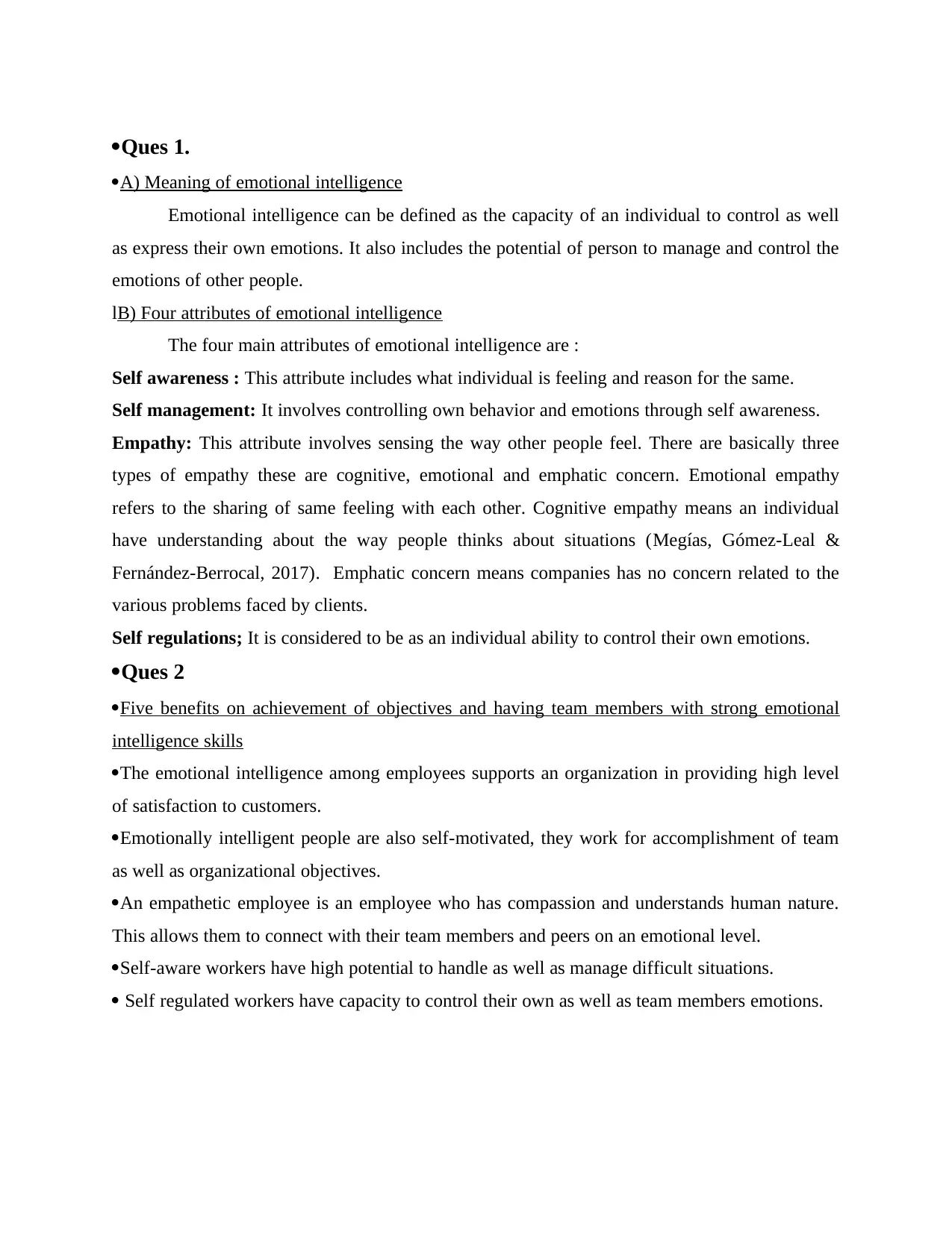
·Ques 1.
·A) Meaning of emotional intelligence
Emotional intelligence can be defined as the capacity of an individual to control as well
as express their own emotions. It also includes the potential of person to manage and control the
emotions of other people.
lB) Four attributes of emotional intelligence
The four main attributes of emotional intelligence are :
Self awareness : This attribute includes what individual is feeling and reason for the same.
Self management: It involves controlling own behavior and emotions through self awareness.
Empathy: This attribute involves sensing the way other people feel. There are basically three
types of empathy these are cognitive, emotional and emphatic concern. Emotional empathy
refers to the sharing of same feeling with each other. Cognitive empathy means an individual
have understanding about the way people thinks about situations (Megías, Gómez-Leal &
Fernández-Berrocal, 2017). Emphatic concern means companies has no concern related to the
various problems faced by clients.
Self regulations; It is considered to be as an individual ability to control their own emotions.
·Ques 2
·Five benefits on achievement of objectives and having team members with strong emotional
intelligence skills
·The emotional intelligence among employees supports an organization in providing high level
of satisfaction to customers.
·Emotionally intelligent people are also self-motivated, they work for accomplishment of team
as well as organizational objectives.
·An empathetic employee is an employee who has compassion and understands human nature.
This allows them to connect with their team members and peers on an emotional level.
·Self-aware workers have high potential to handle as well as manage difficult situations.
· Self regulated workers have capacity to control their own as well as team members emotions.
·A) Meaning of emotional intelligence
Emotional intelligence can be defined as the capacity of an individual to control as well
as express their own emotions. It also includes the potential of person to manage and control the
emotions of other people.
lB) Four attributes of emotional intelligence
The four main attributes of emotional intelligence are :
Self awareness : This attribute includes what individual is feeling and reason for the same.
Self management: It involves controlling own behavior and emotions through self awareness.
Empathy: This attribute involves sensing the way other people feel. There are basically three
types of empathy these are cognitive, emotional and emphatic concern. Emotional empathy
refers to the sharing of same feeling with each other. Cognitive empathy means an individual
have understanding about the way people thinks about situations (Megías, Gómez-Leal &
Fernández-Berrocal, 2017). Emphatic concern means companies has no concern related to the
various problems faced by clients.
Self regulations; It is considered to be as an individual ability to control their own emotions.
·Ques 2
·Five benefits on achievement of objectives and having team members with strong emotional
intelligence skills
·The emotional intelligence among employees supports an organization in providing high level
of satisfaction to customers.
·Emotionally intelligent people are also self-motivated, they work for accomplishment of team
as well as organizational objectives.
·An empathetic employee is an employee who has compassion and understands human nature.
This allows them to connect with their team members and peers on an emotional level.
·Self-aware workers have high potential to handle as well as manage difficult situations.
· Self regulated workers have capacity to control their own as well as team members emotions.
Paraphrase This Document
Need a fresh take? Get an instant paraphrase of this document with our AI Paraphraser
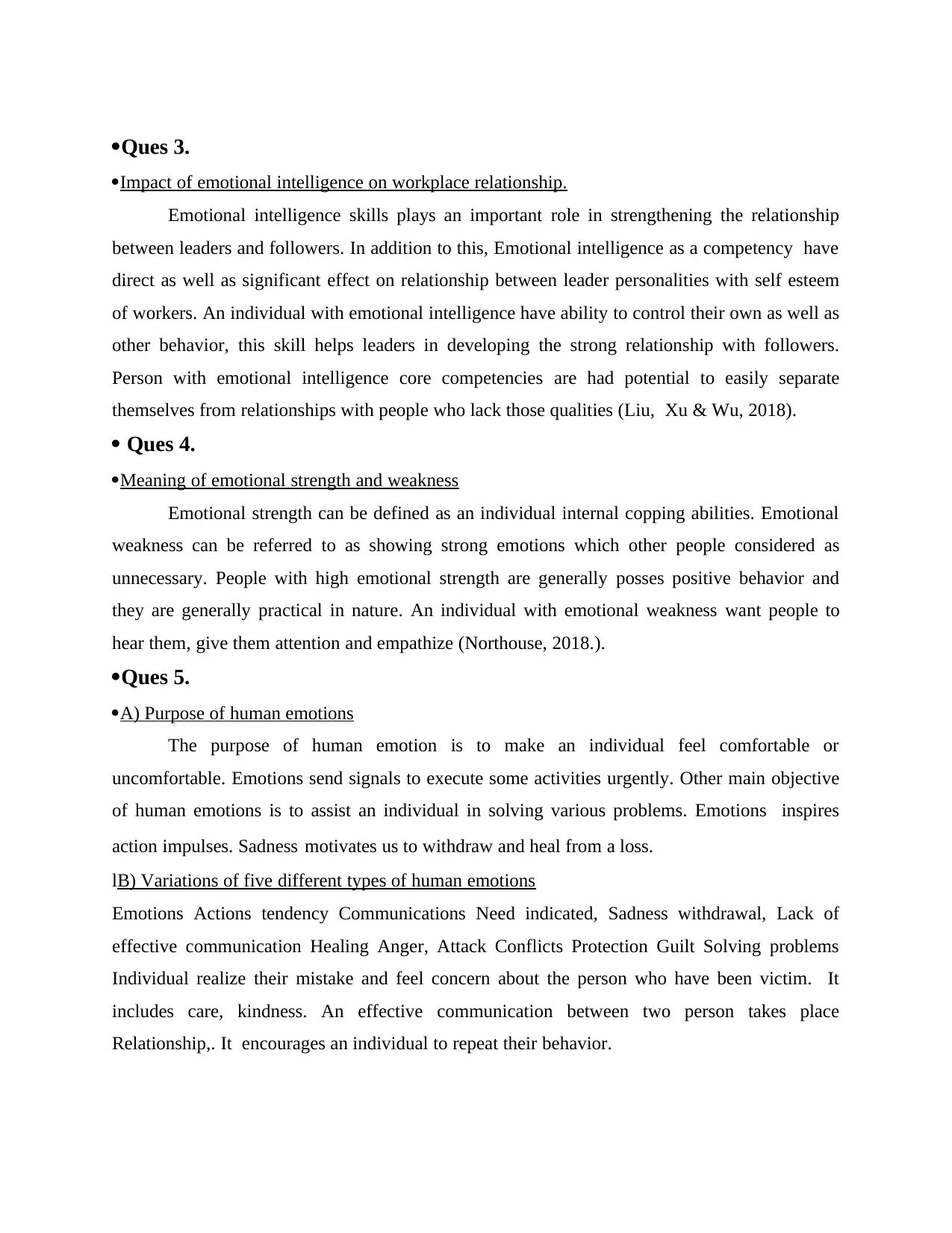
·Ques 3.
·Impact of emotional intelligence on workplace relationship.
Emotional intelligence skills plays an important role in strengthening the relationship
between leaders and followers. In addition to this, Emotional intelligence as a competency have
direct as well as significant effect on relationship between leader personalities with self esteem
of workers. An individual with emotional intelligence have ability to control their own as well as
other behavior, this skill helps leaders in developing the strong relationship with followers.
Person with emotional intelligence core competencies are had potential to easily separate
themselves from relationships with people who lack those qualities (Liu, Xu & Wu, 2018).
· Ques 4.
·Meaning of emotional strength and weakness
Emotional strength can be defined as an individual internal copping abilities. Emotional
weakness can be referred to as showing strong emotions which other people considered as
unnecessary. People with high emotional strength are generally posses positive behavior and
they are generally practical in nature. An individual with emotional weakness want people to
hear them, give them attention and empathize (Northouse, 2018.).
·Ques 5.
·A) Purpose of human emotions
The purpose of human emotion is to make an individual feel comfortable or
uncomfortable. Emotions send signals to execute some activities urgently. Other main objective
of human emotions is to assist an individual in solving various problems. Emotions inspires
action impulses. Sadness motivates us to withdraw and heal from a loss.
lB) Variations of five different types of human emotions
Emotions Actions tendency Communications Need indicated, Sadness withdrawal, Lack of
effective communication Healing Anger, Attack Conflicts Protection Guilt Solving problems
Individual realize their mistake and feel concern about the person who have been victim. It
includes care, kindness. An effective communication between two person takes place
Relationship,. It encourages an individual to repeat their behavior.
·Impact of emotional intelligence on workplace relationship.
Emotional intelligence skills plays an important role in strengthening the relationship
between leaders and followers. In addition to this, Emotional intelligence as a competency have
direct as well as significant effect on relationship between leader personalities with self esteem
of workers. An individual with emotional intelligence have ability to control their own as well as
other behavior, this skill helps leaders in developing the strong relationship with followers.
Person with emotional intelligence core competencies are had potential to easily separate
themselves from relationships with people who lack those qualities (Liu, Xu & Wu, 2018).
· Ques 4.
·Meaning of emotional strength and weakness
Emotional strength can be defined as an individual internal copping abilities. Emotional
weakness can be referred to as showing strong emotions which other people considered as
unnecessary. People with high emotional strength are generally posses positive behavior and
they are generally practical in nature. An individual with emotional weakness want people to
hear them, give them attention and empathize (Northouse, 2018.).
·Ques 5.
·A) Purpose of human emotions
The purpose of human emotion is to make an individual feel comfortable or
uncomfortable. Emotions send signals to execute some activities urgently. Other main objective
of human emotions is to assist an individual in solving various problems. Emotions inspires
action impulses. Sadness motivates us to withdraw and heal from a loss.
lB) Variations of five different types of human emotions
Emotions Actions tendency Communications Need indicated, Sadness withdrawal, Lack of
effective communication Healing Anger, Attack Conflicts Protection Guilt Solving problems
Individual realize their mistake and feel concern about the person who have been victim. It
includes care, kindness. An effective communication between two person takes place
Relationship,. It encourages an individual to repeat their behavior.
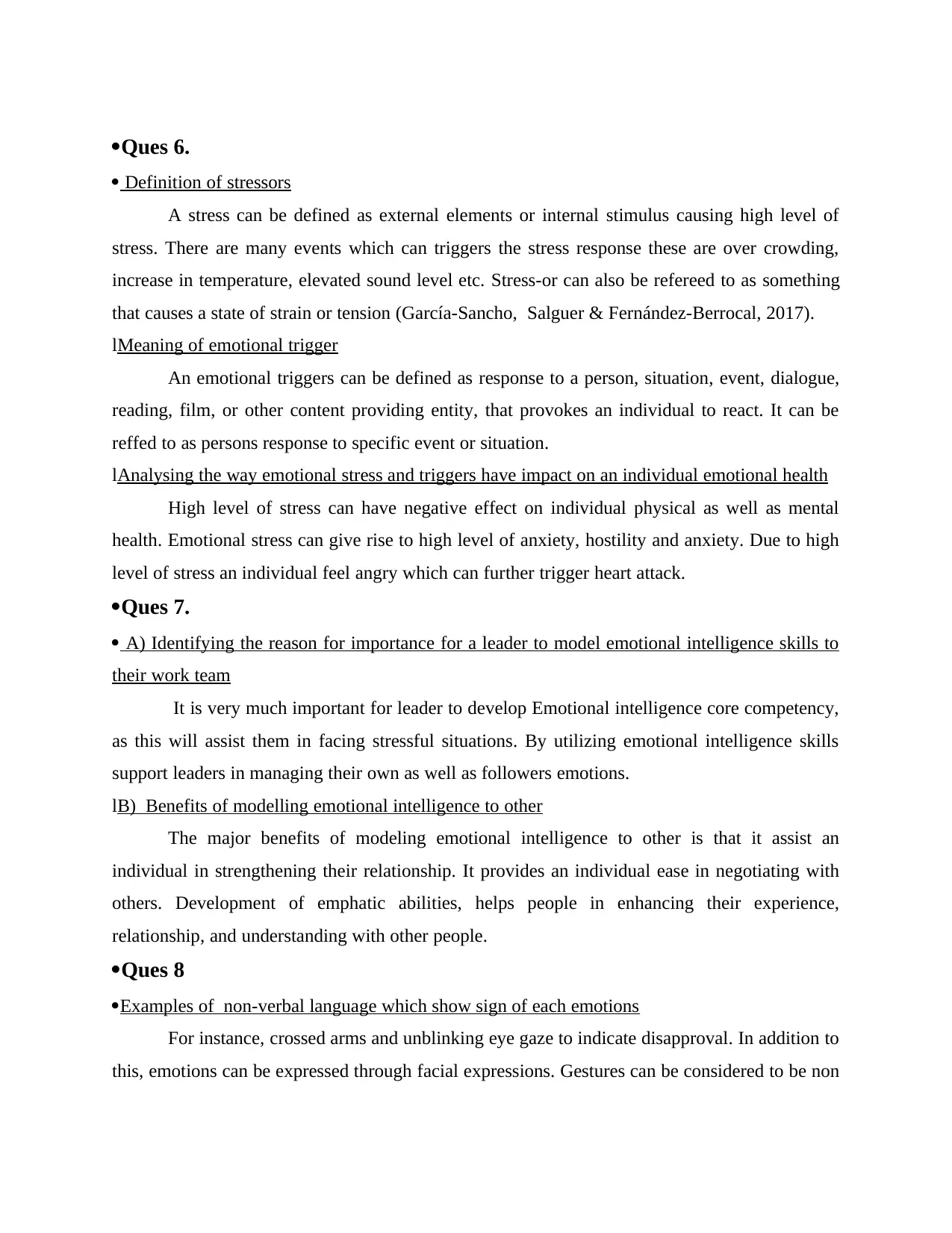
·Ques 6.
· Definition of stressors
A stress can be defined as external elements or internal stimulus causing high level of
stress. There are many events which can triggers the stress response these are over crowding,
increase in temperature, elevated sound level etc. Stress-or can also be refereed to as something
that causes a state of strain or tension (García-Sancho, Salguer & Fernández-Berrocal, 2017).
lMeaning of emotional trigger
An emotional triggers can be defined as response to a person, situation, event, dialogue,
reading, film, or other content providing entity, that provokes an individual to react. It can be
reffed to as persons response to specific event or situation.
lAnalysing the way emotional stress and triggers have impact on an individual emotional health
High level of stress can have negative effect on individual physical as well as mental
health. Emotional stress can give rise to high level of anxiety, hostility and anxiety. Due to high
level of stress an individual feel angry which can further trigger heart attack.
·Ques 7.
· A) Identifying the reason for importance for a leader to model emotional intelligence skills to
their work team
It is very much important for leader to develop Emotional intelligence core competency,
as this will assist them in facing stressful situations. By utilizing emotional intelligence skills
support leaders in managing their own as well as followers emotions.
lB) Benefits of modelling emotional intelligence to other
The major benefits of modeling emotional intelligence to other is that it assist an
individual in strengthening their relationship. It provides an individual ease in negotiating with
others. Development of emphatic abilities, helps people in enhancing their experience,
relationship, and understanding with other people.
·Ques 8
·Examples of non-verbal language which show sign of each emotions
For instance, crossed arms and unblinking eye gaze to indicate disapproval. In addition to
this, emotions can be expressed through facial expressions. Gestures can be considered to be non
· Definition of stressors
A stress can be defined as external elements or internal stimulus causing high level of
stress. There are many events which can triggers the stress response these are over crowding,
increase in temperature, elevated sound level etc. Stress-or can also be refereed to as something
that causes a state of strain or tension (García-Sancho, Salguer & Fernández-Berrocal, 2017).
lMeaning of emotional trigger
An emotional triggers can be defined as response to a person, situation, event, dialogue,
reading, film, or other content providing entity, that provokes an individual to react. It can be
reffed to as persons response to specific event or situation.
lAnalysing the way emotional stress and triggers have impact on an individual emotional health
High level of stress can have negative effect on individual physical as well as mental
health. Emotional stress can give rise to high level of anxiety, hostility and anxiety. Due to high
level of stress an individual feel angry which can further trigger heart attack.
·Ques 7.
· A) Identifying the reason for importance for a leader to model emotional intelligence skills to
their work team
It is very much important for leader to develop Emotional intelligence core competency,
as this will assist them in facing stressful situations. By utilizing emotional intelligence skills
support leaders in managing their own as well as followers emotions.
lB) Benefits of modelling emotional intelligence to other
The major benefits of modeling emotional intelligence to other is that it assist an
individual in strengthening their relationship. It provides an individual ease in negotiating with
others. Development of emphatic abilities, helps people in enhancing their experience,
relationship, and understanding with other people.
·Ques 8
·Examples of non-verbal language which show sign of each emotions
For instance, crossed arms and unblinking eye gaze to indicate disapproval. In addition to
this, emotions can be expressed through facial expressions. Gestures can be considered to be non
⊘ This is a preview!⊘
Do you want full access?
Subscribe today to unlock all pages.

Trusted by 1+ million students worldwide
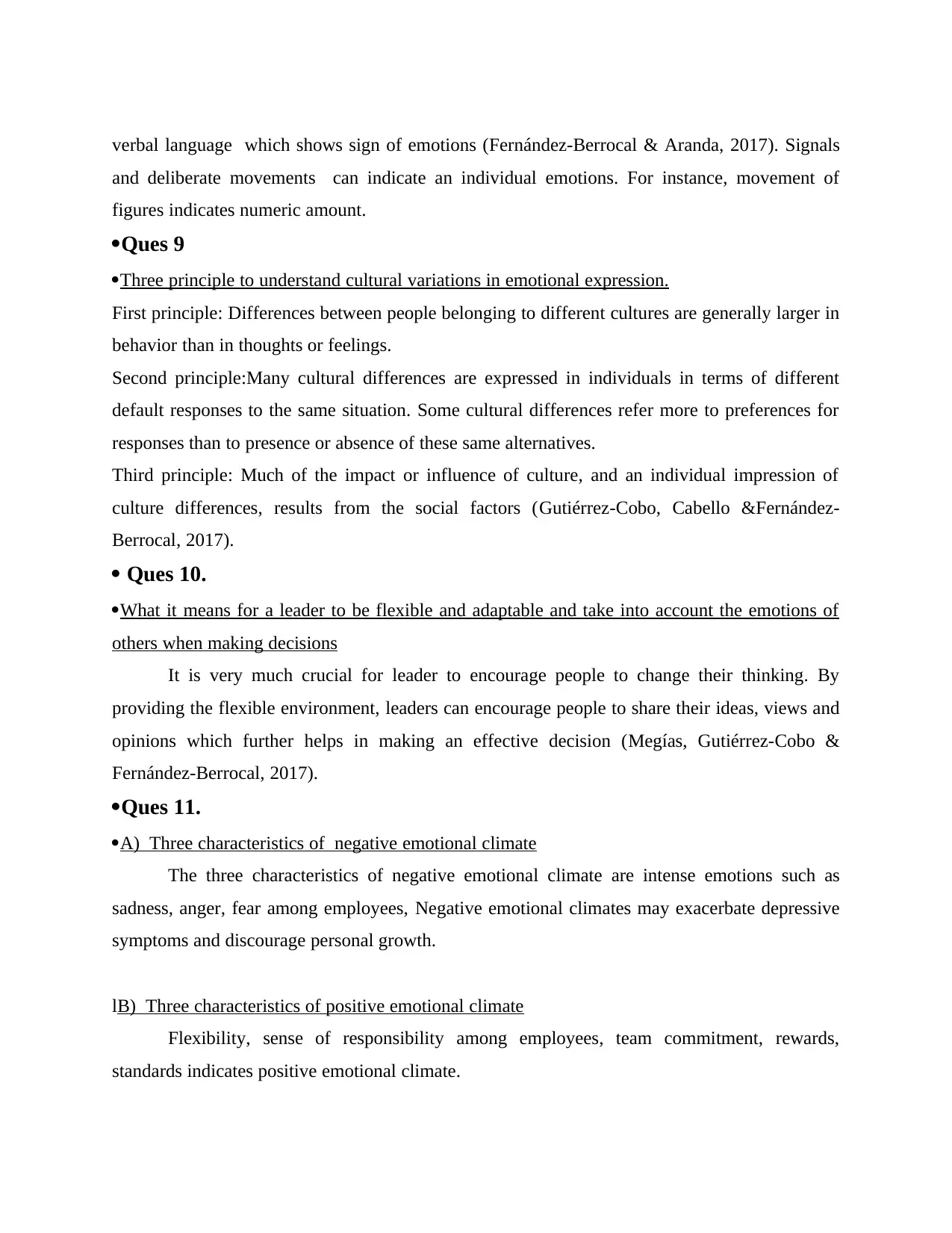
verbal language which shows sign of emotions (Fernández-Berrocal & Aranda, 2017). Signals
and deliberate movements can indicate an individual emotions. For instance, movement of
figures indicates numeric amount.
·Ques 9
·Three principle to understand cultural variations in emotional expression.
First principle: Differences between people belonging to different cultures are generally larger in
behavior than in thoughts or feelings.
Second principle:Many cultural differences are expressed in individuals in terms of different
default responses to the same situation. Some cultural differences refer more to preferences for
responses than to presence or absence of these same alternatives.
Third principle: Much of the impact or influence of culture, and an individual impression of
culture differences, results from the social factors (Gutiérrez-Cobo, Cabello &Fernández-
Berrocal, 2017).
· Ques 10.
·What it means for a leader to be flexible and adaptable and take into account the emotions of
others when making decisions
It is very much crucial for leader to encourage people to change their thinking. By
providing the flexible environment, leaders can encourage people to share their ideas, views and
opinions which further helps in making an effective decision (Megías, Gutiérrez-Cobo &
Fernández-Berrocal, 2017).
·Ques 11.
·A) Three characteristics of negative emotional climate
The three characteristics of negative emotional climate are intense emotions such as
sadness, anger, fear among employees, Negative emotional climates may exacerbate depressive
symptoms and discourage personal growth.
lB) Three characteristics of positive emotional climate
Flexibility, sense of responsibility among employees, team commitment, rewards,
standards indicates positive emotional climate.
and deliberate movements can indicate an individual emotions. For instance, movement of
figures indicates numeric amount.
·Ques 9
·Three principle to understand cultural variations in emotional expression.
First principle: Differences between people belonging to different cultures are generally larger in
behavior than in thoughts or feelings.
Second principle:Many cultural differences are expressed in individuals in terms of different
default responses to the same situation. Some cultural differences refer more to preferences for
responses than to presence or absence of these same alternatives.
Third principle: Much of the impact or influence of culture, and an individual impression of
culture differences, results from the social factors (Gutiérrez-Cobo, Cabello &Fernández-
Berrocal, 2017).
· Ques 10.
·What it means for a leader to be flexible and adaptable and take into account the emotions of
others when making decisions
It is very much crucial for leader to encourage people to change their thinking. By
providing the flexible environment, leaders can encourage people to share their ideas, views and
opinions which further helps in making an effective decision (Megías, Gutiérrez-Cobo &
Fernández-Berrocal, 2017).
·Ques 11.
·A) Three characteristics of negative emotional climate
The three characteristics of negative emotional climate are intense emotions such as
sadness, anger, fear among employees, Negative emotional climates may exacerbate depressive
symptoms and discourage personal growth.
lB) Three characteristics of positive emotional climate
Flexibility, sense of responsibility among employees, team commitment, rewards,
standards indicates positive emotional climate.
Paraphrase This Document
Need a fresh take? Get an instant paraphrase of this document with our AI Paraphraser

lC) Leadership style which an individual can adopt for ensuring positive emotional climate
It is very much important for leaders to adopt the supportive or participate leadership
style, as this will help them in developing positive emotional climate at workplace.
·Ques 12.
·Technique to encourage workers to express their emotion
It is required by leaders in an enterprise to facilitate an effective communication and
provide flexibility, as this strategy will assist leaders in encouraging employees to share their
emotions.
·Ques 13.
·A) Analysing the way leader utilities emotional strength of others while working in a team
Leaders utilities their emotional strength for recognition their team members the greatest
strengths and in determining the way it can be utilized for achieving success. M
lB) Reason for identifying and utilizing strength in a team environment.
Maximizing on the strengths of employees cultivates positive emotional experiences for
team members and assists them to achieve workplace outcomes efficiently.
It is very much important for leaders to adopt the supportive or participate leadership
style, as this will help them in developing positive emotional climate at workplace.
·Ques 12.
·Technique to encourage workers to express their emotion
It is required by leaders in an enterprise to facilitate an effective communication and
provide flexibility, as this strategy will assist leaders in encouraging employees to share their
emotions.
·Ques 13.
·A) Analysing the way leader utilities emotional strength of others while working in a team
Leaders utilities their emotional strength for recognition their team members the greatest
strengths and in determining the way it can be utilized for achieving success. M
lB) Reason for identifying and utilizing strength in a team environment.
Maximizing on the strengths of employees cultivates positive emotional experiences for
team members and assists them to achieve workplace outcomes efficiently.
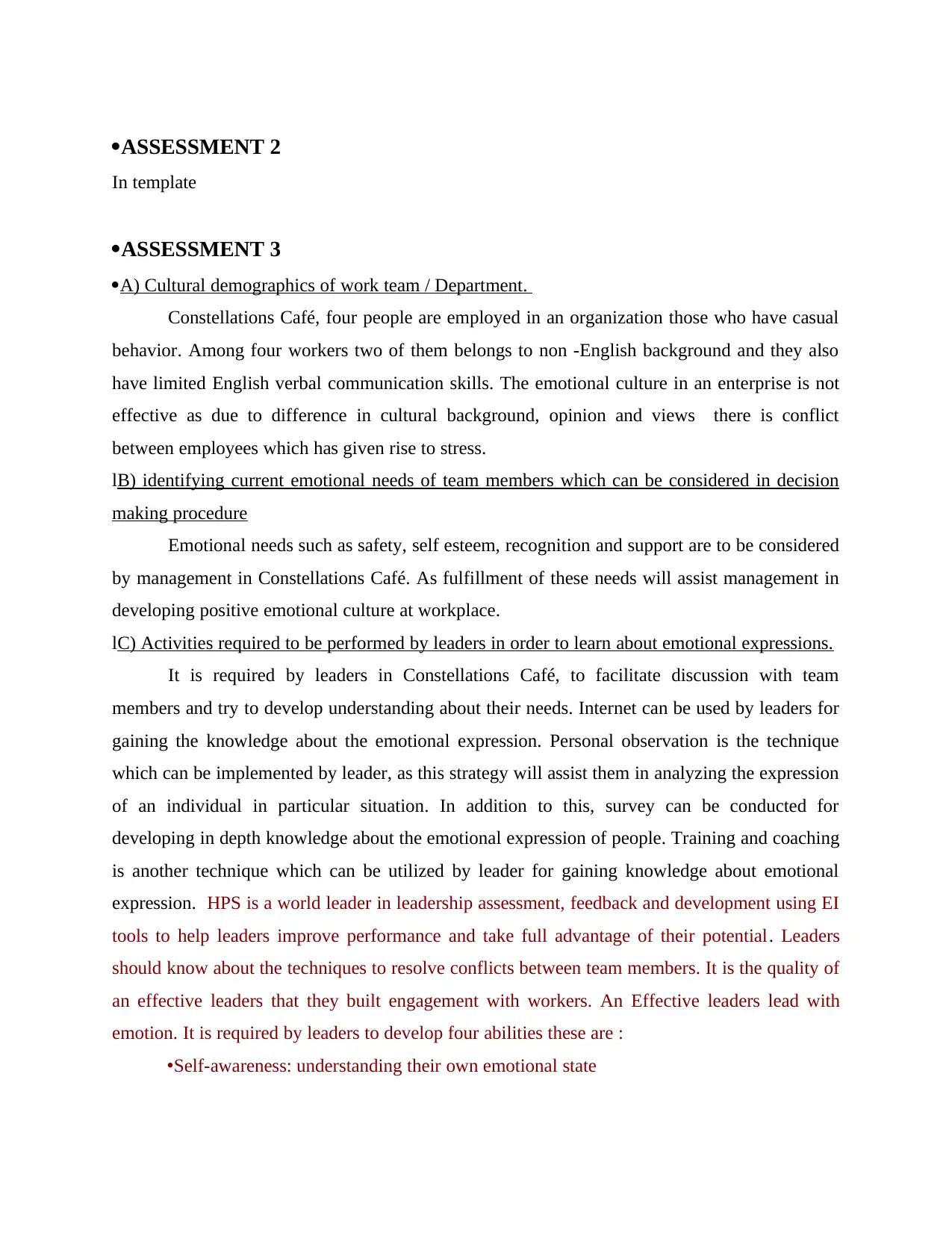
·ASSESSMENT 2
In template
·ASSESSMENT 3
·A) Cultural demographics of work team / Department.
Constellations Café, four people are employed in an organization those who have casual
behavior. Among four workers two of them belongs to non -English background and they also
have limited English verbal communication skills. The emotional culture in an enterprise is not
effective as due to difference in cultural background, opinion and views there is conflict
between employees which has given rise to stress.
lB) identifying current emotional needs of team members which can be considered in decision
making procedure
Emotional needs such as safety, self esteem, recognition and support are to be considered
by management in Constellations Café. As fulfillment of these needs will assist management in
developing positive emotional culture at workplace.
lC) Activities required to be performed by leaders in order to learn about emotional expressions.
It is required by leaders in Constellations Café, to facilitate discussion with team
members and try to develop understanding about their needs. Internet can be used by leaders for
gaining the knowledge about the emotional expression. Personal observation is the technique
which can be implemented by leader, as this strategy will assist them in analyzing the expression
of an individual in particular situation. In addition to this, survey can be conducted for
developing in depth knowledge about the emotional expression of people. Training and coaching
is another technique which can be utilized by leader for gaining knowledge about emotional
expression. HPS is a world leader in leadership assessment, feedback and development using EI
tools to help leaders improve performance and take full advantage of their potential. Leaders
should know about the techniques to resolve conflicts between team members. It is the quality of
an effective leaders that they built engagement with workers. An Effective leaders lead with
emotion. It is required by leaders to develop four abilities these are :
•Self-awareness: understanding their own emotional state
In template
·ASSESSMENT 3
·A) Cultural demographics of work team / Department.
Constellations Café, four people are employed in an organization those who have casual
behavior. Among four workers two of them belongs to non -English background and they also
have limited English verbal communication skills. The emotional culture in an enterprise is not
effective as due to difference in cultural background, opinion and views there is conflict
between employees which has given rise to stress.
lB) identifying current emotional needs of team members which can be considered in decision
making procedure
Emotional needs such as safety, self esteem, recognition and support are to be considered
by management in Constellations Café. As fulfillment of these needs will assist management in
developing positive emotional culture at workplace.
lC) Activities required to be performed by leaders in order to learn about emotional expressions.
It is required by leaders in Constellations Café, to facilitate discussion with team
members and try to develop understanding about their needs. Internet can be used by leaders for
gaining the knowledge about the emotional expression. Personal observation is the technique
which can be implemented by leader, as this strategy will assist them in analyzing the expression
of an individual in particular situation. In addition to this, survey can be conducted for
developing in depth knowledge about the emotional expression of people. Training and coaching
is another technique which can be utilized by leader for gaining knowledge about emotional
expression. HPS is a world leader in leadership assessment, feedback and development using EI
tools to help leaders improve performance and take full advantage of their potential. Leaders
should know about the techniques to resolve conflicts between team members. It is the quality of
an effective leaders that they built engagement with workers. An Effective leaders lead with
emotion. It is required by leaders to develop four abilities these are :
•Self-awareness: understanding their own emotional state
⊘ This is a preview!⊘
Do you want full access?
Subscribe today to unlock all pages.

Trusted by 1+ million students worldwide
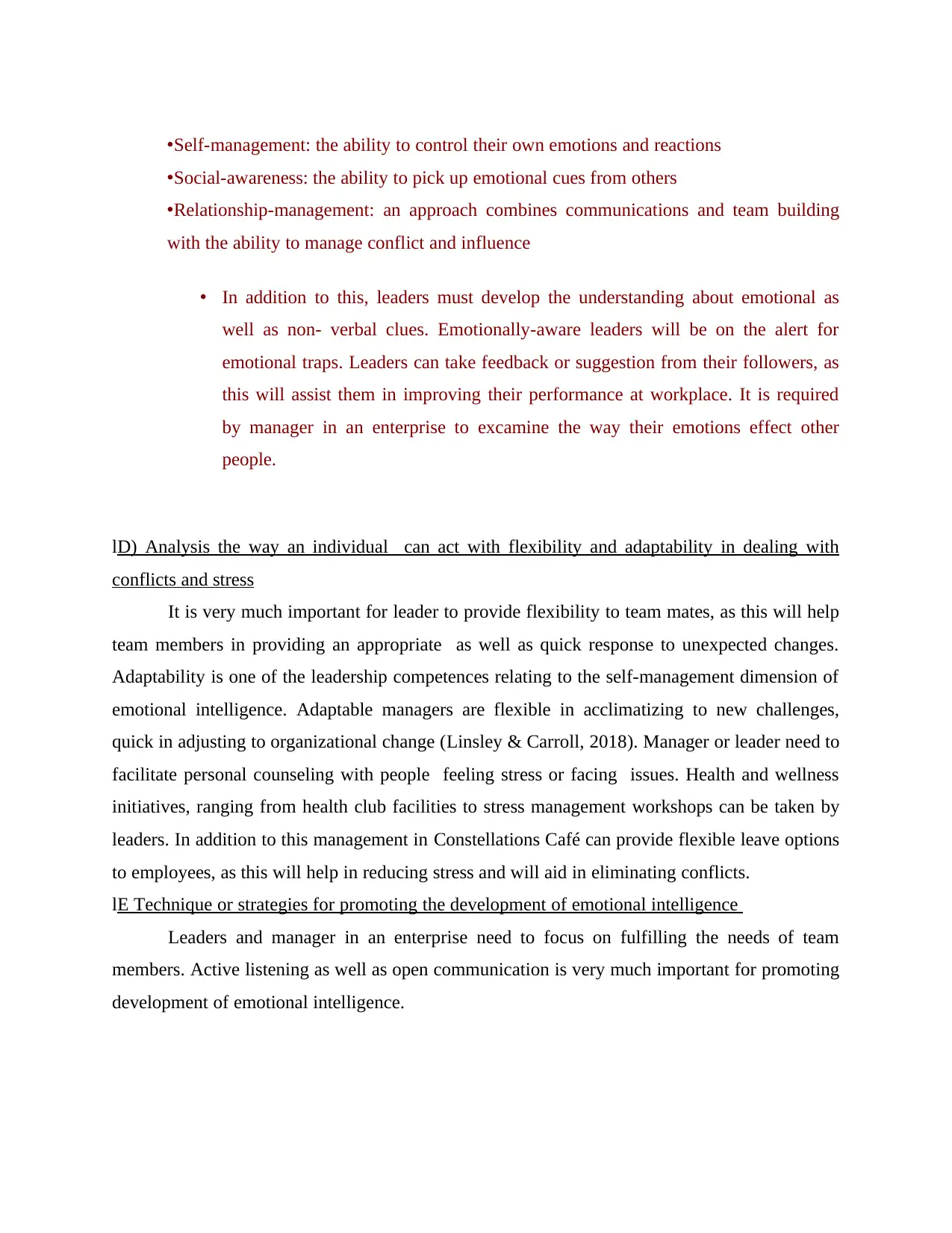
•Self-management: the ability to control their own emotions and reactions
•Social-awareness: the ability to pick up emotional cues from others
•Relationship-management: an approach combines communications and team building
with the ability to manage conflict and influence
• In addition to this, leaders must develop the understanding about emotional as
well as non- verbal clues. Emotionally-aware leaders will be on the alert for
emotional traps. Leaders can take feedback or suggestion from their followers, as
this will assist them in improving their performance at workplace. It is required
by manager in an enterprise to excamine the way their emotions effect other
people.
lD) Analysis the way an individual can act with flexibility and adaptability in dealing with
conflicts and stress
It is very much important for leader to provide flexibility to team mates, as this will help
team members in providing an appropriate as well as quick response to unexpected changes.
Adaptability is one of the leadership competences relating to the self-management dimension of
emotional intelligence. Adaptable managers are flexible in acclimatizing to new challenges,
quick in adjusting to organizational change (Linsley & Carroll, 2018). Manager or leader need to
facilitate personal counseling with people feeling stress or facing issues. Health and wellness
initiatives, ranging from health club facilities to stress management workshops can be taken by
leaders. In addition to this management in Constellations Café can provide flexible leave options
to employees, as this will help in reducing stress and will aid in eliminating conflicts.
lE Technique or strategies for promoting the development of emotional intelligence
Leaders and manager in an enterprise need to focus on fulfilling the needs of team
members. Active listening as well as open communication is very much important for promoting
development of emotional intelligence.
•Social-awareness: the ability to pick up emotional cues from others
•Relationship-management: an approach combines communications and team building
with the ability to manage conflict and influence
• In addition to this, leaders must develop the understanding about emotional as
well as non- verbal clues. Emotionally-aware leaders will be on the alert for
emotional traps. Leaders can take feedback or suggestion from their followers, as
this will assist them in improving their performance at workplace. It is required
by manager in an enterprise to excamine the way their emotions effect other
people.
lD) Analysis the way an individual can act with flexibility and adaptability in dealing with
conflicts and stress
It is very much important for leader to provide flexibility to team mates, as this will help
team members in providing an appropriate as well as quick response to unexpected changes.
Adaptability is one of the leadership competences relating to the self-management dimension of
emotional intelligence. Adaptable managers are flexible in acclimatizing to new challenges,
quick in adjusting to organizational change (Linsley & Carroll, 2018). Manager or leader need to
facilitate personal counseling with people feeling stress or facing issues. Health and wellness
initiatives, ranging from health club facilities to stress management workshops can be taken by
leaders. In addition to this management in Constellations Café can provide flexible leave options
to employees, as this will help in reducing stress and will aid in eliminating conflicts.
lE Technique or strategies for promoting the development of emotional intelligence
Leaders and manager in an enterprise need to focus on fulfilling the needs of team
members. Active listening as well as open communication is very much important for promoting
development of emotional intelligence.
Paraphrase This Document
Need a fresh take? Get an instant paraphrase of this document with our AI Paraphraser

lF) Strategies for encouraging team members for identifying and expressing their thoughts
It is required by leaders or managers in Constellations Café to develop an emotional
healthy workplace environment. Leaders or managers should provide an individual a chance to
express their feeling. Encouraging self reflection is considered to be as an effective technique
which can be utilized for encouraging team members for identifying and expressing their
thoughts. It is required by leaders in an organization to develop social skills.Customized EI training
can help team members learn how:
Individual EI “fits” with the EI of other team members, managers, clients, etc.
Work assignments can be made and accomplished more effectively
to improve communication
to minimize the negative aspects of conflict
to present information most effectively
to design more effective problem solving groups
to assist team members in maximizing their individual and collective strengths
lG) Rating the emotional climate of the work team
I will give 1 Rating to emotional climate of the work team considering the conflicts
between team members, stress etc.
lH) Strategies for promoting an improvement in emotional climate
Encourage cooperation and collaboration so that the differences between team members
become organizational assets. It is required by leaders or manager in Constellations Café to
establish clear goals and clearly defined role as well as responsibilities of an individual. Manager
or leader in an enterprise should provide regular feedback to team members. Generating
emotional awareness is very effective technique which can be utilized for promoting an
improvement in emotional climate (Zysberg, Bar Yoseph, & Goldman,2017)..
lI) Techniques for identifying the current emotional strength which exist within a team
It is required by leader in an disorganization to facilitate an effective communication
with team members and participate with them in group activities, as this strategy will help
It is required by leaders or managers in Constellations Café to develop an emotional
healthy workplace environment. Leaders or managers should provide an individual a chance to
express their feeling. Encouraging self reflection is considered to be as an effective technique
which can be utilized for encouraging team members for identifying and expressing their
thoughts. It is required by leaders in an organization to develop social skills.Customized EI training
can help team members learn how:
Individual EI “fits” with the EI of other team members, managers, clients, etc.
Work assignments can be made and accomplished more effectively
to improve communication
to minimize the negative aspects of conflict
to present information most effectively
to design more effective problem solving groups
to assist team members in maximizing their individual and collective strengths
lG) Rating the emotional climate of the work team
I will give 1 Rating to emotional climate of the work team considering the conflicts
between team members, stress etc.
lH) Strategies for promoting an improvement in emotional climate
Encourage cooperation and collaboration so that the differences between team members
become organizational assets. It is required by leaders or manager in Constellations Café to
establish clear goals and clearly defined role as well as responsibilities of an individual. Manager
or leader in an enterprise should provide regular feedback to team members. Generating
emotional awareness is very effective technique which can be utilized for promoting an
improvement in emotional climate (Zysberg, Bar Yoseph, & Goldman,2017)..
lI) Techniques for identifying the current emotional strength which exist within a team
It is required by leader in an disorganization to facilitate an effective communication
with team members and participate with them in group activities, as this strategy will help

leaders in analyzing the emotional strength of an individual. The main activity involves
problem-solving, based on a current situation with a team.
lJ) Analysing the practical ways which leader can model the desired emotional intelligent skills
within team
Coaching: It is required by leader to provide coaching to their team members, as this will assist
them in fostering foster a collaborative and emotionally intelligent culture.
Mentoring : Leaders should support or assists team mates in developing understanding about
complex emotional states by encouraging self reflections.
Training: This technique will help people in developing emotional; intelligent skills. It will also
help an individual in improving their performance at workplace (Megías, Gutiérrez-Cobo &
Fernández-Berrocal, 2017).
problem-solving, based on a current situation with a team.
lJ) Analysing the practical ways which leader can model the desired emotional intelligent skills
within team
Coaching: It is required by leader to provide coaching to their team members, as this will assist
them in fostering foster a collaborative and emotionally intelligent culture.
Mentoring : Leaders should support or assists team mates in developing understanding about
complex emotional states by encouraging self reflections.
Training: This technique will help people in developing emotional; intelligent skills. It will also
help an individual in improving their performance at workplace (Megías, Gutiérrez-Cobo &
Fernández-Berrocal, 2017).
⊘ This is a preview!⊘
Do you want full access?
Subscribe today to unlock all pages.

Trusted by 1+ million students worldwide
1 out of 13
Related Documents
Your All-in-One AI-Powered Toolkit for Academic Success.
+13062052269
info@desklib.com
Available 24*7 on WhatsApp / Email
![[object Object]](/_next/static/media/star-bottom.7253800d.svg)
Unlock your academic potential
Copyright © 2020–2025 A2Z Services. All Rights Reserved. Developed and managed by ZUCOL.




